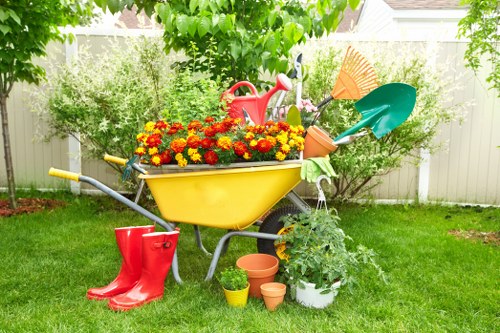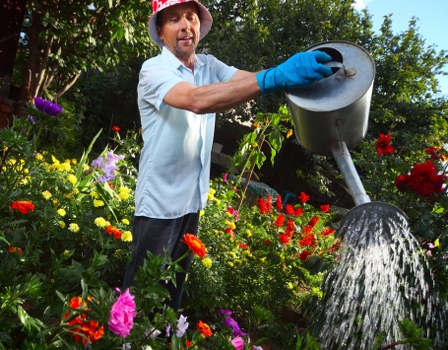Comprehensive Guide to Garden Maintenance in Cleaners E5

Introduction to Garden Maintenance
Maintaining a beautiful garden in Cleaners E5 requires dedication, knowledge, and the right set of tools. Whether you’re a seasoned gardener or a novice, understanding the intricacies of garden maintenance can transform your outdoor space into a lush, thriving haven.
Garden maintenance involves a variety of tasks that ensure the health and aesthetic appeal of your plants and landscape. From regular pruning to soil management, each step plays a crucial role in the overall well-being of your garden.
In Cleaners E5, the climate and soil conditions present unique challenges and opportunities for gardeners. Tailoring your maintenance practices to suit these local conditions can lead to a more vibrant and resilient garden.

Seasonal Garden Maintenance
Spring Maintenance
Spring is a critical time for garden maintenance in Cleaners E5. As the weather warms, plants begin to grow rapidly, making it essential to prepare your garden for the upcoming growing season.
Key tasks in spring include:
- Pruning: Remove dead or damaged branches to encourage healthy growth.
- Weeding: Eliminate unwanted plants that compete with your garden’s flora.
- Soil Preparation: Enrich the soil with compost or fertilizers to provide essential nutrients.
Proper spring maintenance sets the foundation for a flourishing garden throughout the year.

Essential Tools for Garden Maintenance
Pruning Tools
Pruning is a vital aspect of garden maintenance, helping to shape plants and promote healthy growth. Investing in high-quality pruning tools can make this task more efficient and effective.
Top Pruning Tools:
- Shears: Ideal for trimming small branches and shaping plants.
- Pruners: Suitable for cutting thicker branches with ease.
- Loppers: Perfect for handling larger branches that shears and pruners can’t manage.
Regular maintenance of these tools ensures their longevity and performance.

Soil Management
Testing and Improving Soil Quality
Healthy soil is the cornerstone of a successful garden. Testing soil quality helps identify nutrient deficiencies and pH imbalances, allowing you to make informed decisions about soil amendments.
Steps to Manage Soil Quality:
- Soil Testing: Use a soil test kit to determine the nutrient levels and pH balance.
- Adding Amendments: Incorporate compost, organic matter, or specific fertilizers based on test results.
- Mulching: Apply mulch to retain moisture, suppress weeds, and regulate soil temperature.
Consistent soil management leads to healthier plants and a more productive garden.

Pest and Disease Control
Identifying and Managing Pests
Pests and diseases can severely impact the health of your garden. Early identification and effective management strategies are essential to protect your plants.
Common Pests in Cleaners E5:
- Aphids: Small insects that suck sap from plants, causing wilting and stunted growth.
- Slugs and Snails: Mollusks that feed on a variety of plants, leaving behind unsightly holes.
- Spider Mites: Tiny pests that create webs and cause discoloration of leaves.
Implementing integrated pest management (IPM) techniques can effectively reduce pest populations without harming beneficial insects.
Watering Strategies
Efficient Watering Techniques
Proper watering is crucial for maintaining a healthy garden. Overwatering can lead to root rot, while underwatering can stress plants and inhibit growth.
Best Practices for Watering:
- Drip Irrigation: Delivers water directly to the plant roots, minimizing evaporation and runoff.
- Morning Watering: Reduces the risk of fungal diseases by allowing plants to dry during the day.
- Mulching: Helps retain soil moisture and regulate temperature.
Adopting efficient watering strategies ensures that your plants receive the right amount of moisture they need to thrive.
Lawn Care
Mowing and Trimming
A well-maintained lawn enhances the overall appearance of your garden. Regular mowing and trimming prevent overgrowth and promote a neat, uniform look.
Lawn Maintenance Tips:
- Proper Mowing Height: Adjust the mower to the appropriate height for your grass type to encourage deep root growth.
- Regular Trimming: Trim edges and borders to maintain clean lines and prevent weed encroachment.
- Grasscycling: Leave grass clippings on the lawn to decompose and return nutrients to the soil.
Consistent lawn care contributes to a healthy, vibrant outdoor space.
Pruning and Trimming
Techniques for Successful Pruning
Pruning is essential for shaping plants, removing dead or diseased branches, and promoting healthy growth. Understanding proper pruning techniques can significantly improve the health and appearance of your garden.
Pruning Guidelines:
- Know Your Plant: Different plants have specific pruning needs, so familiarize yourself with the requirements of each species in your garden.
- Use Sharp Tools: Ensure your pruning tools are clean and sharp to make precise cuts and prevent damage to the plant.
- Prune at the Right Time: Pruning during the dormant season or after flowering can minimize stress on the plant.
Effective pruning enhances plant health, encourages blooms, and maintains the desired shape of your garden.
Weed Control
Strategies to Keep Your Garden Weed-Free
Weeds compete with your garden plants for nutrients, water, and sunlight. Implementing effective weed control strategies is vital for maintaining a healthy and aesthetically pleasing garden.
Effective Weed Control Methods:
- Manual Removal: Regularly inspect your garden and hand-pull weeds to prevent them from spreading.
- Mulching: Apply a thick layer of mulch to suppress weed growth and retain soil moisture.
- Herbicides: Use chemical or organic herbicides as a last resort to manage persistent weeds.
Maintaining a weed-free garden reduces competition and allows your plants to thrive.
Fertilization
Feeding Your Plants for Optimal Growth
Fertilization provides essential nutrients that promote healthy plant growth and blooming. Understanding the nutritional needs of your plants ensures they receive the right balance of nutrients.
Types of Fertilizers:
- Organic Fertilizers: Natural options like compost, manure, and bone meal enrich the soil without harmful chemicals.
- Inorganic Fertilizers: Synthetic fertilizers offer precise nutrient ratios but should be used sparingly to avoid soil imbalance.
- Slow-Release Fertilizers: Provide a steady supply of nutrients over time, reducing the need for frequent application.
Regular fertilization tailored to your garden’s needs supports robust plant health and vibrant growth.
Garden Design and Layout
Planning an Efficient Garden Layout
A well-designed garden layout enhances functionality and aesthetic appeal. Thoughtful planning ensures that plants have adequate space, sunlight, and air circulation.
Key Considerations in Garden Design:
- Plant Selection: Choose plants that complement each other in terms of size, color, and growth habits.
- Sunlight Requirements: Group plants with similar sunlight needs together to optimize their growth conditions.
- Pathways and Access: Incorporate clear pathways for easy access to different garden areas for maintenance.
A strategic garden layout facilitates efficient maintenance and creates a visually appealing outdoor space.
Mulching Techniques
Benefits of Mulching Your Garden
Mulching is a vital practice in garden maintenance that offers numerous benefits, including moisture retention, temperature regulation, and weed suppression.
Types of Mulch:
- Organic Mulch: Materials like wood chips, straw, and leaves enrich the soil as they decompose.
- Inorganic Mulch: Options such as gravel, pebbles, and rubber mulch provide long-lasting coverage without decomposing.
- Chemical Mulch: Synthetic mulches designed to prevent weed growth without adding nutrients to the soil.
Applying mulch correctly enhances soil health, conserves water, and maintains an attractive garden appearance.
Pruning Trees and Shrubs
Maintaining Healthy Trees and Shrubs
Proper pruning of trees and shrubs is essential for their health, safety, and aesthetic appeal. Regular maintenance prevents disease, reduces the risk of damage, and promotes vigorous growth.
Pruning Tips for Trees and Shrubs:
- Remove Dead or Diseased Branches: Identify and cut away unhealthy branches to prevent the spread of disease.
- Shape the Canopy: Trim branches to maintain a balanced shape and allow light penetration.
- Encourage New Growth: Selective pruning stimulates the development of new shoots and foliage.
Consistent pruning practices ensure the longevity and beauty of your trees and shrubs.
Composting
Creating and Using Compost
Composting is an eco-friendly practice that recycles organic waste into a valuable soil amendment. It enriches the soil, improves its structure, and provides essential nutrients to plants.
Steps to Create Compost:
- Gather Materials: Collect green materials (kitchen scraps, fresh grass clippings) and brown materials (dry leaves, branches).
- Build the Pile: Alternate layers of green and brown materials to create a balanced compost heap.
- Maintain the Pile: Turn the compost regularly to aerate it and monitor moisture levels for optimal decomposition.
Utilizing compost in your garden reduces waste and enhances soil fertility naturally.
Integrated Pest Management
Sustainable Approaches to Pest Control
Integrated Pest Management (IPM) is a sustainable approach to controlling pests by combining biological, cultural, mechanical, and chemical methods. It aims to minimize the use of harmful pesticides while effectively managing pest populations.
Components of IPM:
- Biological Control: Introduce natural predators or beneficial insects that prey on pests.
- Cultural Practices: Implement gardening techniques that reduce pest habitats and increase plant resilience.
- Mechanical Control: Use physical barriers, traps, or manual removal to manage pest populations.
- Chemical Control: Apply pesticides judiciously as a last resort, choosing targeted and eco-friendly options.
Adopting IPM strategies promotes a balanced ecosystem in your garden, fostering healthy plant growth and reducing pest-related issues.
Garden Lighting
Enhancing Your Garden with Lighting
Garden lighting not only adds beauty and ambiance but also extends the usability of your outdoor space into the evening hours. Proper lighting highlights key features and ensures safety.
Types of Garden Lighting:
- Path Lights: Illuminate walkways to guide visitors and prevent accidents.
- Spotlights: Highlight specific garden features like trees, sculptures, or architectural elements.
- String Lights: Create a cozy and inviting atmosphere for outdoor gatherings.
Integrating thoughtful lighting solutions enhances the overall appeal and functionality of your garden.
Irrigation Systems
Installing Efficient Irrigation Solutions
Installing an efficient irrigation system ensures that your garden receives adequate water, reducing the time and effort required for manual watering. Automated systems provide consistency and precision in watering your plants.
Popular Irrigation Systems:
- Drip Irrigation: Delivers water directly to the plant roots, minimizing waste and evaporation.
- Sprinkler Systems: Ideal for covering large areas with even water distribution.
- Provide a slow and steady water supply along the length of the hose, perfect for garden beds.
Choosing the right irrigation system tailored to your garden’s needs enhances water efficiency and promotes healthy plant growth.
Pruning Flower Beds
Maintaining Vibrant Flower Beds
Pruning flower beds is essential for encouraging continuous blooming and preventing overcrowding. Regular maintenance ensures that your flowers remain healthy and vibrant throughout the growing season.
Flower Bed Pruning Tips:
- Deadheading: Remove spent flowers to encourage new blooms and extend the flowering period.
- Pinching Back: Trim the tips of plants to promote bushier growth and prevent legginess.
- Thinning: Remove excess stems to improve air circulation and reduce the risk of disease.
Consistent pruning of flower beds results in a lively and attractive garden display.
Comprehensive Garden Care
Maintaining All Aspects of Your Garden
Comprehensive garden care involves addressing every aspect of your outdoor space, from plant health to landscape aesthetics. A holistic approach ensures that your garden remains balanced, healthy, and visually appealing.
Key Areas of Focus:
- Plant Health: Regular monitoring and care to prevent diseases and pests.
- Soil Fertility: Continuous soil management to maintain nutrient-rich ground.
- Aesthetic Enhancements: Incorporate elements like garden art, water features, and seating areas to enhance visual appeal.
Adopting a comprehensive garden care routine ensures long-term success and enjoyment of your outdoor space.
Conclusion
Effective garden maintenance in Cleaners E5 is a blend of knowledge, dedication, and the right techniques. By understanding seasonal needs, utilizing proper tools, managing soil and pests, and incorporating thoughtful design elements, you can cultivate a thriving and beautiful garden.
If you're ready to transform your garden into a stunning oasis, contact us today or book your service now to get started on your garden maintenance journey.


